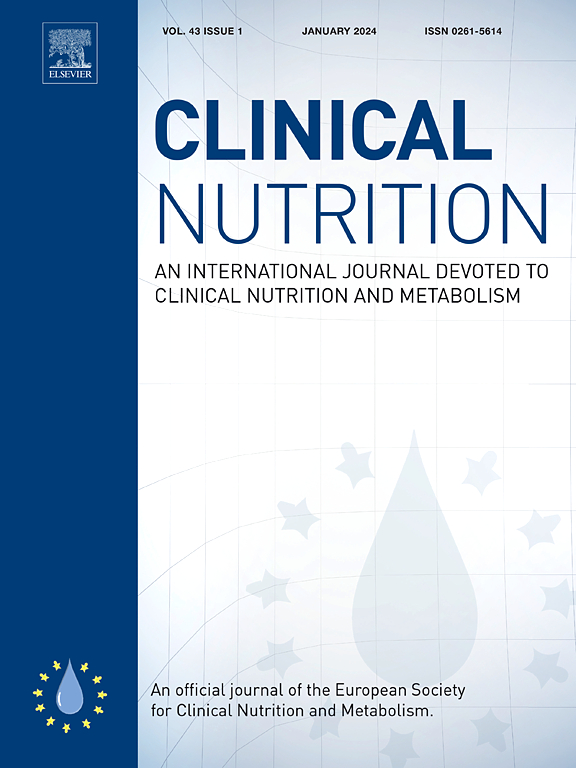Joint associations of handgrip strength and physical activity with incident cardiovascular disease and overall mortality in the UK Biobank
IF 6.6
2区 医学
Q1 NUTRITION & DIETETICS
引用次数: 0
Abstract
Background & aims
Questions remain whether higher handgrip strength confers additional health advantages beyond adherence to current physical activity guidelines. We aimed to evaluate prospective associations of joint objectively measured handgrip strength and physical activity with incident cardiovascular disease (CVD) and all-cause mortality.
Methods
We analysed the UK Biobank study in a cohort of participants who wore accelerometers for one week, with follow-up based on hospital records until 2022. Patterns of physical activity were compared: participants who met current moderate-vigorous physical activity guidelines (150 min per week) and those who did not. Handgrip strength was classified into sex- and age-specific tertiles. CVD events were identified as primary or secondary by examination of inpatient records and data extracted from the death registry. CVD-related deaths were also identified from the death registry. We examined prospective associations of moderate-vigorous physical activity with incident CVD and all-cause mortality by level of handgrip using Cox regressions, adjusted for confounding factors.
Results
A total of 76 074 persons were included (mean 55.2 years). Meeting physical activity guidelines is necessary to reduce all-cause mortality in those at the lower and middle thirds of handgrip strength. However, meeting physical activity guidelines did not confer additional reduction of all-cause mortality of those with high handgrip strength. Those with the lowest handgrip strength showed the greatest benefit from meeting physical activity guidelines for reducing all-cause mortality (HR 0.74; 95 % CI 0.65–0.85).
Conclusion
Our results indicate that, while following physical activity guidelines does not reduce mortality in individuals with high handgrip strength, it is essential for preventing cardiovascular disease across all levels of handgrip strength. This underscores the importance of these guidelines for cardiovascular health.
英国生物库中手握强度和体力活动与心血管疾病发病率和总死亡率的共同关系
背景& 目的除了遵守目前的体育锻炼指南外,较高的握力是否还能带来更多的健康益处,这个问题仍然存在。我们旨在评估联合客观测量的手握力和体力活动与心血管疾病(CVD)发病率和全因死亡率之间的前瞻性关联。方法我们分析了英国生物库研究的一组参与者,他们佩戴了一周的加速度计,并根据医院记录进行随访至2022年。我们对参与者的体育锻炼模式进行了比较:符合当前中等强度体育锻炼指南(每周 150 分钟)的参与者和不符合指南的参与者。手握强度按性别和年龄分为三等分。通过检查住院病历和从死亡登记处提取的数据,确定心血管疾病事件为原发性或继发性。与心血管疾病相关的死亡病例也从死亡登记处获得。我们使用 Cox 回归法,并根据混杂因素进行调整,研究了中等强度体力活动与心血管疾病事件和全因死亡率之间的前瞻性关系。达到体育锻炼指南的要求是降低手握力处于中下三等分者全因死亡率的必要条件。然而,符合体育锻炼指南并不能额外降低高握力人群的全因死亡率。结论我们的研究结果表明,虽然遵循体育锻炼指南并不能降低手握力量大的人的死亡率,但它对预防所有手握力量水平的人的心血管疾病至关重要。这强调了这些指南对心血管健康的重要性。
本文章由计算机程序翻译,如有差异,请以英文原文为准。
求助全文
约1分钟内获得全文
求助全文
来源期刊

Clinical nutrition
医学-营养学
CiteScore
14.10
自引率
6.30%
发文量
356
审稿时长
28 days
期刊介绍:
Clinical Nutrition, the official journal of ESPEN, The European Society for Clinical Nutrition and Metabolism, is an international journal providing essential scientific information on nutritional and metabolic care and the relationship between nutrition and disease both in the setting of basic science and clinical practice. Published bi-monthly, each issue combines original articles and reviews providing an invaluable reference for any specialist concerned with these fields.
 求助内容:
求助内容: 应助结果提醒方式:
应助结果提醒方式:


